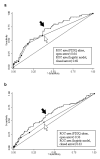Can a screening questionnaire accurately identify mild Parkinsonian signs?
- PMID: 22948126
- PMCID: PMC3513756
- DOI: 10.1159/000341409
Can a screening questionnaire accurately identify mild Parkinsonian signs?
Abstract
Background: Mild parkinsonian signs (MPS) are early features that, when present, increase the risk of neurodegenerative disease and mortality. Current methods to identify MPS are limited to neurological examination. Our objective was to assess the ability of a 9-item Parkinson's Disease Screening Questionnaire (PDSQ), which has high sensitivity in the detection of overt Parkinson's disease (PD), to detect MPS.
Methods: Measures including the PDSQ, Unified Parkinson's Disease Rating Scale and University of Pennsylvania Smell Identification Test were administered to 267 participants without neurodegenerative disease. Two published definitions of MPS were used to classify cases.
Results: PDSQ scores were higher for cases compared to controls (p < 0.001 for the first case definition and 0.07 for the second). However, the questionnaire had low sensitivity (47 and 59%) and specificity (62 and 63%) in the detection of MPS. Adding factors such as age, gender and smell test score to the questionnaire in a predictive model only marginally improved the test characteristics.
Conclusion: The results show the screening questionnaire does not accurately identify MPS. More accurate tests are needed to improve the detection of this early syndrome which can lead to motor disability, neurodegenerative disease and mortality.
Copyright © 2012 S. Karger AG, Basel.
Figures

Similar articles
-
Mild Parkinsonian Signs in a Community Ambulant Population.J Parkinsons Dis. 2020;10(3):1231-1237. doi: 10.3233/JPD-191849. J Parkinsons Dis. 2020. PMID: 32310187
-
Reasons for mild parkinsonian signs - which constellation may indicate neurodegeneration?Parkinsonism Relat Disord. 2015 Feb;21(2):126-30. doi: 10.1016/j.parkreldis.2014.11.018. Epub 2014 Nov 28. Parkinsonism Relat Disord. 2015. PMID: 25511329
-
Predictors for mild parkinsonian signs: a prospective population-based study.Parkinsonism Relat Disord. 2015 Mar;21(3):321-4. doi: 10.1016/j.parkreldis.2014.12.021. Epub 2014 Dec 31. Parkinsonism Relat Disord. 2015. PMID: 25585991
-
Functional correlates and prevalence of mild parkinsonian signs in a community population of older people.Arch Neurol. 2005 Feb;62(2):297-302. doi: 10.1001/archneur.62.2.297. Arch Neurol. 2005. PMID: 15710859
-
Fatigue rating scales critique and recommendations by the Movement Disorders Society task force on rating scales for Parkinson's disease.Mov Disord. 2010 May 15;25(7):805-22. doi: 10.1002/mds.22989. Mov Disord. 2010. PMID: 20461797 Review.
Cited by
-
Parkinsonian signs are a risk factor for falls.Gait Posture. 2017 Jun;55:1-5. doi: 10.1016/j.gaitpost.2017.03.039. Epub 2017 Apr 4. Gait Posture. 2017. PMID: 28407503 Free PMC article.
-
Improved diagnosis of Parkinson's disease from a detailed olfactory phenotype.Ann Clin Transl Neurol. 2017 Sep 8;4(10):714-721. doi: 10.1002/acn3.447. eCollection 2017 Oct. Ann Clin Transl Neurol. 2017. PMID: 29046880 Free PMC article.
References
-
- Louis ED, Bennett DA. Mild parkinsonian signs: An overview of an emerging concept. Mov Disord. 2007;22:1681–1688. - PubMed
-
- Louis ED, Luchsinger JA, Tang MX, Mayeux R. Parkinsonian signs in older people - prevalence and associations with smoking and coffee. Neurology. 2003;61:24–28. - PubMed
-
- Louis ED, Tang MX, Schupf N, Mayeux R. Functional correlates and prevalence of mild parkinsonian signs in a community population of older people. Arch Neurol. 2005;62:297–302. - PubMed
-
- Bennett DA, Beckett LA, Murray AM, Shannon KM, Goetz CG, Pilgrim DM, Evans DA. Prevalence of parkinsonian signs and associated mortality in a community population of older people. N Engl J Med. 1996;334:71–76. - PubMed
-
- Louis ED, Tang MX, Mayeux R. Parkinsonian signs in older people in a community-based study. Arch Neurol. 2004;61:1273–1276. - PubMed
Publication types
MeSH terms
Grants and funding
LinkOut - more resources
Full Text Sources
Medical

